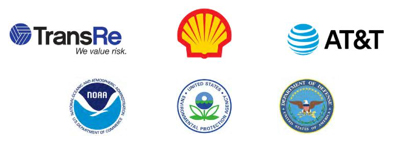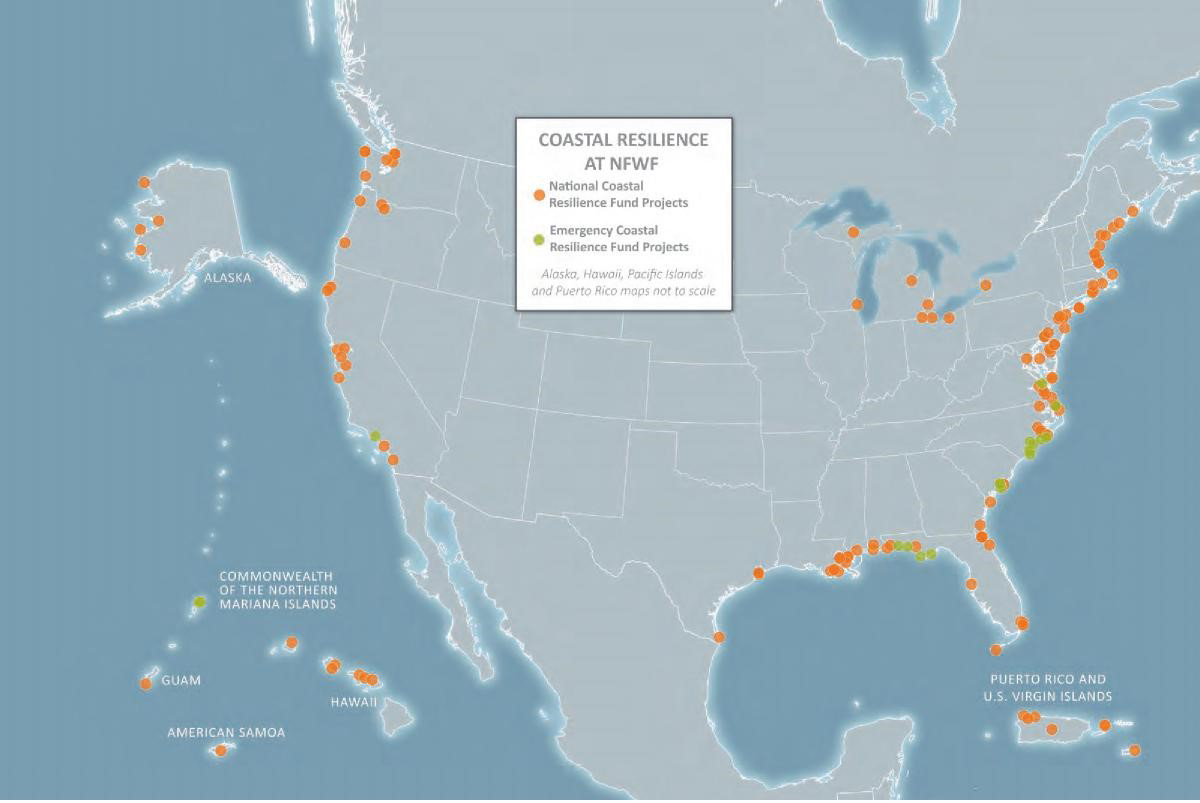National Coastal Resilience Fund
We at TransRe have supported the National Coastal Resilience Fund, a public-private partnership between the National Oceanic Atmospheric Administration and the National Fish and Wildlife Foundation (NFWF).
The National Fish and Wildlife Foundation is an American government-backed agency for sustaining fish, wildlife, plants and habitats.
Coastal Resilience
(The below is an excerpt from National Fish and Wildlife Foundation’s 2020 Annual Report)
Sustaining, restoring and enhancing the nation’s fish, wildlife, plants and habitats for current and future generations — this is NFWF’s mission.
To advance that mission, the Foundation must serve a leading role in national efforts to ensure that wildlife populations and human communities can adapt to changing environmental conditions and withstand the stresses, disruptions and disasters of the modern world. The Foundation and its partners must invest in resilience, and they must do so at a landscape scale.
The stakes couldn’t be higher along the nation’s coasts, which are being battered by increasingly intense storms and threatened by sea-level rise. These same vulnerable areas are home to rich natural resources, enormous metropolitan areas, global trade centers, vital defense installations — and about 130 million people.
Recognizing the need to accelerate investment in coastal resilience, including projects that encourage innovative new approaches to addressing this challenge, NFWF worked with NOAA to launch the National Coastal Resilience Fund. Since 2018, the fund has awarded $90 million to enhance, build, or restore almost 17,800 acres of coastal habitat. Projects have provided enhanced protection to 100,400 properties and 2,500 critical facilities or pieces of nature-based infrastructure. To meet the growing demand from prospective grantees, NFWF has welcomed additional funding partners and supporters to the program, including Shell Oil Company, TransRe, AT&T, the U.S. Environmental Protection Agency and the U.S. Department of Defense.
In fiscal year 2020, the Foundation also awarded nearly $50 million in grants through another resilience-focused program, the Emergency Coastal Resilience Fund. Leveraging emergency appropriations by Congress, NFWF created this fund to address widespread destruction from hurricanes Florence and Michael, Typhoon Yutu and a number of wildfires in 2018.
The grants awarded through these new programs build on NFWF’s deep experience in funding coastal conservation in heavily populated watersheds, including those feeding the Chesapeake Bay, Long Island Sound, Puget Sound and the Great Lakes.

EMPLOYING A SCIENTIFIC APPROACH
A number of factors continue to drive explosive growth in the demand for projects that strengthen resilience, including coastal population growth, increasing risks from hurricanes, and widespread declines in coastal wildlife populations. In its first three years, the National Coastal Resilience Fund received 336 grant applications, of which 124 earned grant awards.
We employ scientific approaches to determine which projects would maximize benefits to wildlife and human communities. NFWF recently worked with NOAA, the University of North Carolina Asheville and other partners to develop an assessment tool to identify coastal locations where nature-based infrastructure would benefit wildlife while also protecting vital community assets such as storm evacuation routes and hospitals.
INVESTING IN NATURE-BASED INFRASTRUCTURE
Many of the resilience-related grants we awarded in 2020 supported innovative efforts to build nature-based infrastructure that provides a buffer from storms, absorbs and filters stormwater runoff, and provides high-quality habitats for wildlife. In addition to immediate benefits to wildlife and community resilience, these shovel-ready projects deliver an economic boost to coastal areas. Examples of our 2020 grant-making include:
In Florida, the Apalachee Regional Planning Council will use a grant of $7.4 million to create nearshore reefs that will support expansive intertidal salt marshes, protect 12 miles of populated shoreline and shield critical hurricane evacuation routes.
Along the coast of Alabama, the Mobile County Commission will leverage a $4.9 million grant to create a breakwater that will absorb storm energy and shield the only hurricane evacuation route from Dauphin Island. The project will also restore marsh habitat and enhance populations of oysters, blue crabs and shrimp.
NFWF awarded $2.5 million to the Jefferson Parish Department of Environmental Affairs to rebuild a 1-mile living shoreline and create up to 70 acres of marsh, tidal creeks and lagoons to provide nursery and refuge habitat for fish, shrimp and blue crabs in Louisiana. The new shoreline and marsh along Lake Pontchartrain will help defend more than 1,000 homes and critical infrastructure from storm surge.
Mariana Islands Nature Alliance is using a $2.5 million grant to remove marine debris from Typhoon Yutu in coastal areas of Saipan and Tinian. If left in place, sunken ships and other storm debris can continually shift and damage these highly productive but fragile habitats.

In Washington, the Lower Columbia Estuary Partnership is using a $2 million grant to reconfigure a 5.5-mile levee system and reconnect 960 acres of floodplain along the lower Columbia River. This project will reduce the risk of frequent flooding at an industrial park, wastewater treatment plant and residential neighborhoods. The project also will improve rearing habitat for salmon, steelhead, and Pacific lamprey; and re-establish unobstructed fish passage to a 7-square-mile watershed.
In North Carolina, the Carteret County Shore Protection Office is using a $1.5 million grant to construct living shorelines to protect the communities of Beaufort and Down East. The project will also protect commercially and recreationally important fish and shellfish populations while sustaining the largest colony of nesting royal terns in North Carolina.
The University of Guam is using a $856,000 grant to scale up the restoration of staghorn corals on the biologically diverse reefs that protect the vulnerable territory from the worst effects of typhoons.
In Virginia, The Nature Conservancy will apply an $800,000 grant toward the creation of new oyster reefs that will create high-quality wildlife habitat, address the erosion within an ecologically valuable salt marsh and protect the vulnerable seaside town of Wachapreague.
BUILDING A PIPELINE FOR FUTURE INVESTMENTS
Under the direction of the U.S. Congress, NFWF is building on successes in funding shovel-ready coastal resilience projects by also building a nationwide pipeline of projects for the critical years ahead.
Congressional leaders recognize that many coastal communities lack the expertise and resources to complete the complicated, in-depth planning required to identify cost-effective projects and push them from inception to actual work in the field. Throughout 2020, NFWF invested in efforts to bridge this critical gap.
The National Coastal Resilience Fund awarded grants to support planning and project design in Alaska, California, Delaware, the District of Columbia, Georgia, Hawaii, Louisiana, Maine, Michigan, New Hampshire, New Jersey, New York, North Carolina, Ohio, Pennsylvania, Puerto Rico, Rhode Island, South Carolina and Washington.
Watch the video to see NFWF in action and learn more about the National Coastal Resilience Fund
Our Research & Resilience Efforts
We have a diligent and systematic approach to investigating global perils that are impacting various communities at large. Its goal is to discover or revise facts, reach new conclusions, discover new information or achieve new insights that will improve the lives of those impacted by challenging conditions throughout the world.View Research & Resilience
Our Global Volunteerism
We have consistently empowered our employees that have passion to want to give back to their communities. We at TransRe provide time, resources and financial commitment to various nonprofits and volunteer organizations with their local communities.- We develop the next generation of leaders through education and mentorship
- We encourage community service and civic participation
- We support sustainability efforts around the rebuilding of local communities